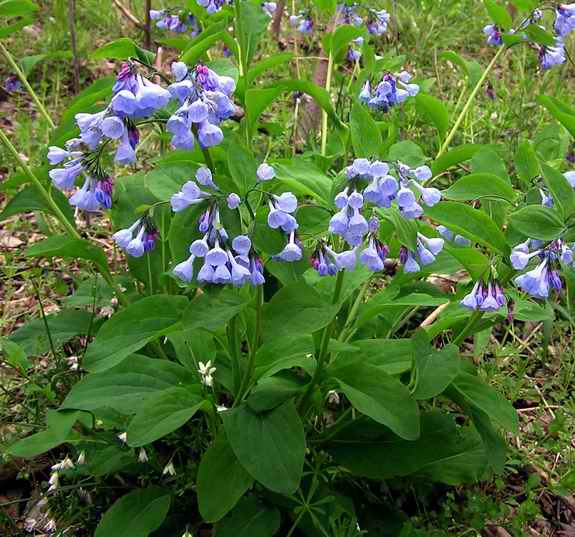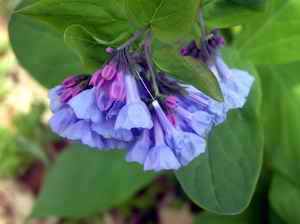|
Return to Hiker's Notebook Home Page
Common Name: Virginia Bluebells, Virginia Cowslip, Tree Lungwort, Roanoke-bells, Mertens, Oysterleaf.
Scientific Name: Mertensia virginica - The generic name honors Franz Karl Mertens, a German botanist (1764-1831) who was a noted collector of plants, especially algae; the species name refers to Virginia, where the plant was first identified.
The many common names of Virginia Bluebells attest to its arresting blue efflorescence, a characteristic worthy of special note by early colonists. John Custis of Williamsburg, Virginia referred to them as "Mountain blew cowslip" in his correspondence with Peter Collinson in London in the 1740's. The cowslip (Primula veris) is a common flower in temperate Europe and Asia which blooms in April with 10-30 flowers on a single stem, much like Virginia Bluebells. The fact that cowslips are yellow did not deter those who saw a resemblance between the two from sowing the seeds of confusion. Thomas Jefferson grew Virginia Bluebells at Monticello which inspired the garden writers of the 18th Century from calling them "Jefferson's blue funnel flowers."
The name lungwort is also a case of mistaken identity. The European lungwort (Pulmonaria officinalis) also has blue "funnel" shaped flowers and it is probable that Virginia Bluebells were mistaken for a North American lungwort variant. The European lungwort was fairly well known, as its spotted leaves were thought by early herbalists to resemble diseased, ulcerated lungs. Thus, according to the Doctrine of Signatures, the plant was prescribed for the treatment of pulmonary disorders. The genus name is derived from pulmo, the Latin word for lung. Virginia bluebells have no known medicinal properties that pertain to lung diseases. Virginia bluebells have two interesting properties that contribute to their success as ephemeral wild flowers. Virginia bluebells form buds that are pink in color due to the anthocyanin (from the Greek anthos meaning flower and kyanos meaning blue) or colored cell sap that they contain. When the flower is ready for pollination, it increases its alkalinity to change the red pigmentation into blue pigmentation, a color that is much more attractive to pollinators. When the flower is pollinated and seed formation begins, it falls to the ground so that subsequent pollinators will only find those that still require their ministrations. The ubiquity of bluebells in their preferred riparian habitat (like Bull Run and the Potomac River Valley) is testimony to the success of their adaptations to attract insects.
There are at least 18 other species of bluebells in North America; Alpine Bluebells (M. alpine) and Tall Fringe Bluebells (M. ciliata) in the western mountains, Prairie Bluebells (M. lanceolate) in the interior lowlands, and Sea lungwort or Oysterleaf (M. maritima) along the Maine seacoast. The leaves of this maritime species are purported to taste like oysters, not unreasonable given their saline environment. The name has been extended to Virginia Bluebells absent any noticeable oyster taste to its leaves.
Bell-shaped blue flowers are fairly common in Eurasia and North America, suggestive of an evolutionary verisimilitude that is in response to an environmental stimulus, probably related to pollinating insects. English and Scottish Bluebells have been the subject of song and poesy; they are, however, not of the same genus nor even of the same family as Virginia Bluebells. English Bluebells are either Hyacinthoides or Endymion non-scripta and have many common names, including Canterbury Bells, Bats-in-the-Belfry, and Our Lady's Nightcaps. The folklore belief was that if you could turn the flower inside out without tearing it, then you would eventually win the one you loved. The Bluebells of Scotland are Campanula rotundifolia, which in North America is the harebell, a relatively common blue bell-shaped flower of the Northeast and Midwest. In Scottish folklore, fairies were thought to live in the flowers and they were therefore also known as Fairy Bells; witches used an extract of the flower to transform themselves into hares, which were thought to convey mystical powers (which is why they are called harebells). |

